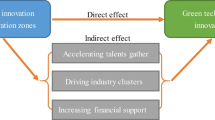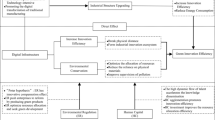Abstract
Based on the global entropy method to evaluate the technological innovation ability and the development level of green economy in Chinese provinces from 2006 to 2015, this paper uses partial least squares (PLS) method to measure the influence of various components of technological innovation ability on the development level of green economy in China. The empirical results show that at the provincial level in China, technological innovation capability has a significant positive impact on the development level of green economy. Among them, the technology input ability has the strongest influence on the development of green economy, followed by the technology output and support ability, while the technology diffusion ability has not formed a significant positive influence on the development level of green economy. The research further finds that the improvement of technology input ability can effectively promote the improvement of technology output, technology support, and technology diffusion ability. For the sake of improving the provincial development level of green economy of China, it is necessary for China’s provinces to enhance their technology input ability and improve their technological innovation resources allocation efficiency.


Similar content being viewed by others
Data Availability
The datasets generated during and/or analyzed during the current study are available from the corresponding author on reasonable request.
References
Liao, C. B. (1999). Quantitative judgement and classification system for coordinated development of environment and economy-A case study of the city group in the Pearl River Delta. Tropical Geography, 19(2), 171–177.
Wu, Y. M., & Zhang, Y. (2008). Analyzing coupled regional economic growth and environmental conservation in China. Resources Science, 30(1), 25–29.
Bai, C. Q., Huang, Y. B., & Song, W. X. (2014). The coupling coordinated development between China’s provincial financial agglomeration and eco-efficiency. Journal of Arid Land Resources and Environment, 28(9), 2–7.
Jiang, K. (2009). Influence of environmental planning upon Chinese technological innovation capacity and analysis of regional differences: Interprovincial panel data analysis of China 1995–2007. Forum on Science and Technology in China, 10, 28–33.
Yang, W. J. (2011). An accounting of green economy growth based on DEA. Journal of Quantitative & Technical Economics, 1, 19–34.
Qin, S. S., & Fu, H. N. (2013). Promoting eco-civilization construction with green technology innovation. Environmental Protection, 41(15), 36–38.
Qian, Z. M., & Liu, X. C. (2014). A study of regional differences and convergence of green eco-efficiency in China. Journal of Xiamen University (Arts & Social Sciences), 1, 110–118.
Jiang, H. Q., Zhang, J., & Zhang, W. (2015). The idea and suggestions to promote the development of environmental protection industry by using the technology innovation. Environmental Protection, 43(8), 36–39.
Liu, Y., Bu, Q., & Peng, C. X. (2016). Relationship between regional technology innovation capability and the quality of economic growth in China. Areal Research and Development, 3, 1–4.
Tian, Y., & Sun, H. (2016). Research on resource-based industry transformation and upgrading under the restriction of low-carbon development. Economic Review, 1, 45–48.
Yu, J. T., & Wang, S. S. (2016). Green growth and green innovation: Empirical evidence from China, US, UK, Germany, Japan and Korea. Studies in Science of Science, 34(04), 528–538.
Zhou, J. M., Zhao, Y. Z., Wu, C. Y., & Xiao, G. R. (2018). Selection of directed technological innovation from the perspective of green growth. Journal of Management Sciences in China, 21(10), 61–73.
Wold, H. (1975). Path models with latent variables: The NIPALS approach. In H. M. Blalock, A. Aganbegian, F. M. Borodkin, R. Boudon, & V. Capecchi (Eds.), Quantitative sociology: International perspectives on mathematical and statistical modeling (pp. 307–357). New York: Academic.
Cassel, C. M., Hackl, P., & Westlund, A. H. (1999). Robustness of partial least-squares method for estimating latent variable quality structures. Journal of Applied Statistics, 26, 435–446.
Tao, Y. H., & Pan, C. Y. (2012). On core competitiveness of Jiangsu shipbuilding industry based on SEM-PLS. Journal of Jiangsu University of Science and Technology (Social Science Edition), 12(01), 101–108.
Huang, Y. C., Li, W., & Yu, F. F. (2015). Analysis of government support for SMEs to grow their own brands mechanism-based on PLS-SEM model under the perspective of value chain. Soft Science, 29(02), 19–23.
Chin, W. W. (1998). The partial least squares approach for structural equation modeling. In G. A. Marcoulides (Ed.), Modern methods for business research (pp. 295–336). Lawrence Erlbaum Associates.
Liu, B. Q., Pan, P. J., & Li, L. M. (2011). Study on the evaluation and difference measurement of regional technological innovation capability development in China. Science & Technology Progress and Policy, 8, 124–128.
Hu, X. J., & Jie, X. M. (2010). Research on regional technology innovation capability evaluation index system based on the concept of synergy. Science & Technology Progress and Policy, 2, 101–104.
Xu, J. (2015). Green economy development: A brief analysis of green economy and technology innovation institutionalization. Collection of Papers for the Annual Academic Meeting of Chinese society For Environmental Sciences (Vol. 1). Chinese Society For Environmental Science.
Yao, S. H., & Ren, X. G. (2007). Science and technology development induced eco-environment negative effect and its system improvement. Science & Technology Progress and Policy, 12, 16–19.
Tang, W. B., Fu, Y. H., & Wang, Z. X. (2014). Technological innovation, technological introduction and economic growth style transition. Economic Research, 49(07), 31–43.
Fu, Y. H., Tang, W. B., & Wang, Z. X. (2010). Mechanism of FDI spillover, path of technical progress and performance of economic growth. Economic Research, 45(06), 92–104.
Kokko, A., Tansini, R., & Zejan, M. C. (1996). Local technological capability and productivity spillovers from FDI in the Uruguayan manufacturing sector. Journal of Development Studies, 32(4), 602–611.
Liu, J. I. (2013). Study on differences of green economic growth cross provinces in China of environmental constraints-based on provincial dynamic panel data analysis. Journal of Xiangtan University (Philosophy and Social Sciences), 2, 69–73.
Sun, J., Liu, W. G., & Zhou, R. D. (2014). China’s opening-up to the outside world, industrial structure and green economy growth–An empirical test based on inter-provincial panel data. Management World, 6, 172–173.
Sun, Y. T., Liu, F. C., & Li, B. (2009). A comparison of national innovation capacity and development mode between China and Europe based on patent. Studies in Science of Science, 27(3), 440–444.
Ding, G., & Chen, Q. (2013). Competitiveness evaluation and promotion strategies of modern service industry’s sub-sectors based on global entropy method: Taking Fujian province as an example. Journal of China University of Petroleum, 6, 14–19.
Bai, J. (2012). Evaluation and comparison of regional technology innovation ability of China. Scientific Management Research, 1, 15–18.
Shao, Y. F., & Tan, J. S. (2006). Research on mechanism and for capacity of regional technological innovation. Journal of Management Sciences in China, 4, 1–11.
Li, Y. P., Yang, C. L., & Sun, R. (2009). Theoretical explorations into regional technology innovation capacity. Science and Technology Management Research, 9, 177–179.
Zhang, X. P., Liu, Z. W., & Zhang, F. (2010). Research on the establishment and evaluation of the regional technology innovation ability index system. Science and Technology Management Research, 21, 69–74.
Cui, R. B. (2002). Green Economy: Dominant form of sustainable economy in the 21st century. Social Science Research, 4, 47–50.
Zhao, B. (2006). Reflections upon green economy theory and practice. Social Science Research, 2, 44–47.
Fang, S. J. (2010). Taking a new look at the development of low-carbon economy from the perspective of green economy. China Population, Resources and Environment, 4, 8–11.
Xia, G. (2010). New interpretations of “green economy.” Environmental Protection, 7, 8–10.
Yang, Z., & Wang, M. Y. (2010). Green economy and production mode globalization transition: A brief introduction of new economy based on the “capital-network-green” framework. Economist, 8, 18–24.
Yang, Y. X. (2011). Differentiation and analysis of ecological economy, circular economy, green economy and low-carbon economy. Forward Position, 8, 94–97.
Zhu, D. J. (2012). New concept of green economy and consideration of deepening green economy studies in China. China Population, Resources and Environment, 5, 40–47.
Ding, G., & Chen, Q. L. (2014). The connotation of green economy and the construction of evaluation index system. Journal of Taiyuan University of Technology (Social Science Edition), 32(01), 1–4.
Funding
This work was supported by these projects: Fuji-an Science and Technology Association Science And Technology Think Tank Major Project (Project No.FJKX-ZD1401) and Philosophy and Social Science Innovation Team Project of Fuzhou University (17TD06).
Author information
Authors and Affiliations
Contributions
GD guided the direction and ideas of the project. XYS analyzed the data and edited the manuscript, and contributed significantly to analysis and manuscript preparation. RW contributed to data analysis. LDG helped perform the analysis with constructive discussions. All authors read and approved the final manuscript.
Corresponding author
Ethics declarations
Competing Interests
The authors declare no competing interests.
Additional information
Publisher's Note
Springer Nature remains neutral with regard to jurisdictional claims in published maps and institutional affiliations.
Rights and permissions
About this article
Cite this article
Ding, G., Su, X., Wang, R. et al. Measurement Research on the Influence of China’s Provincial Technological Innovation Capacity upon Green Economy Development. Environ Model Assess 27, 747–757 (2022). https://doi.org/10.1007/s10666-022-09837-2
Received:
Accepted:
Published:
Issue Date:
DOI: https://doi.org/10.1007/s10666-022-09837-2




